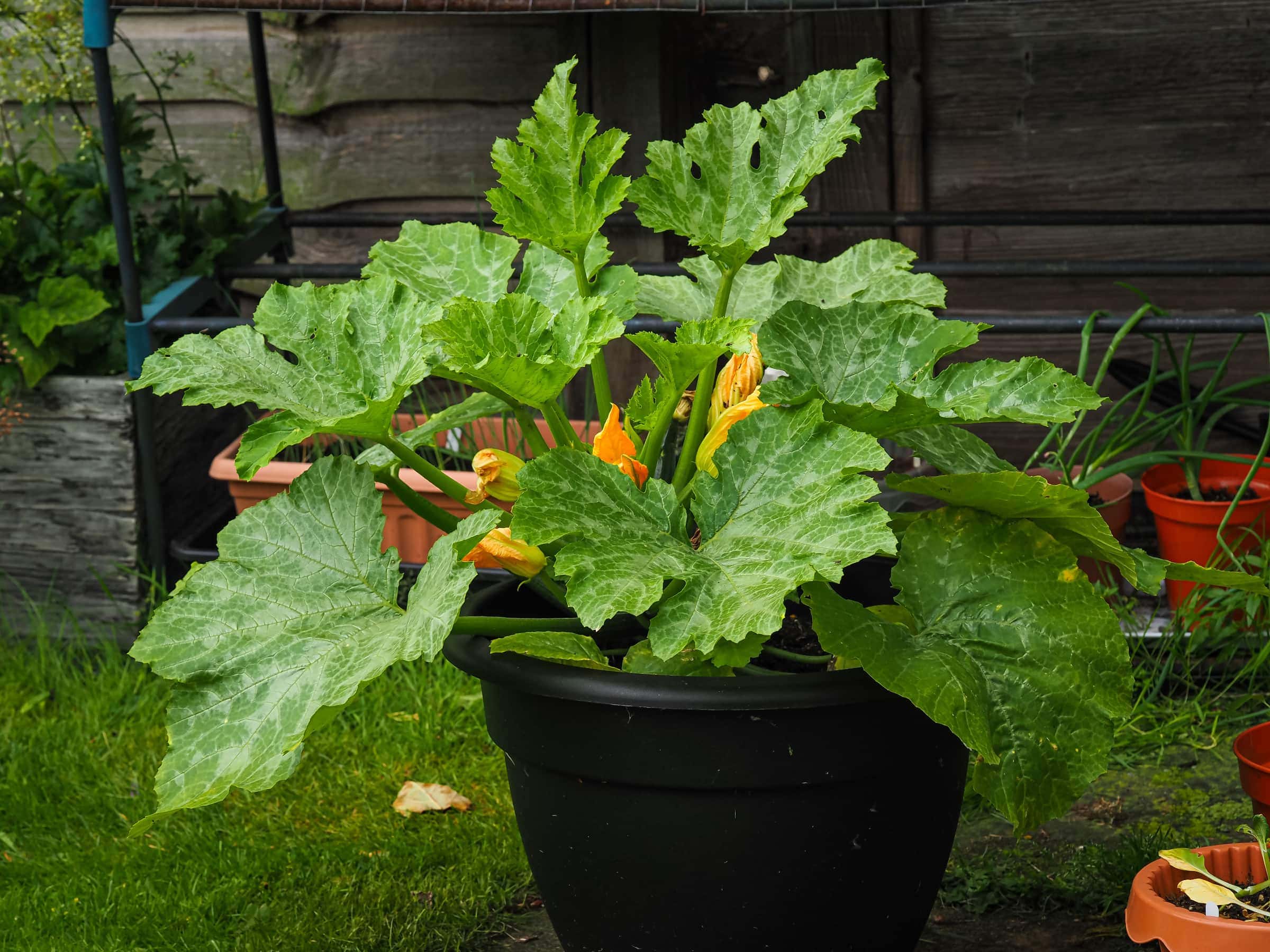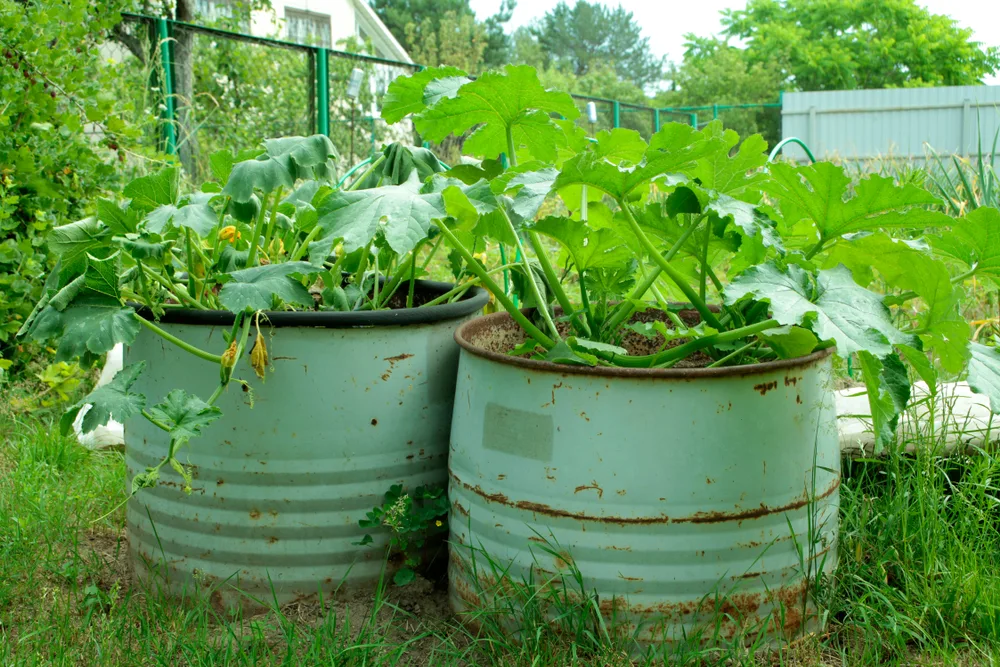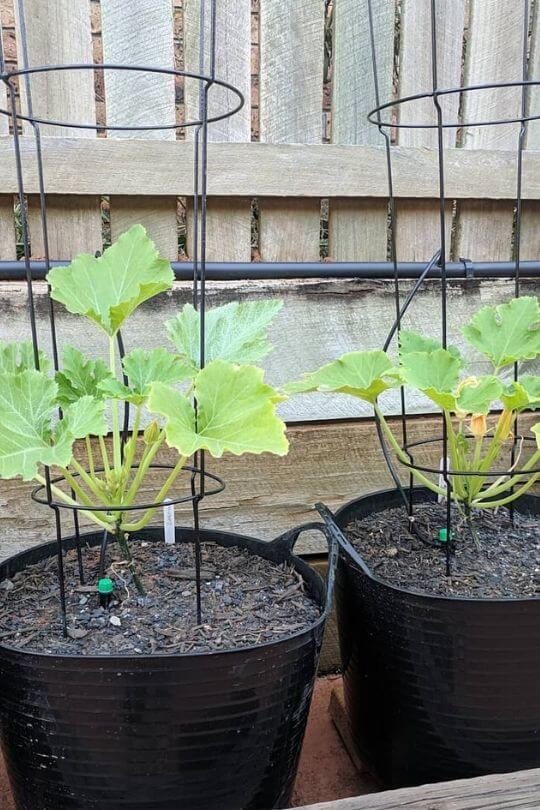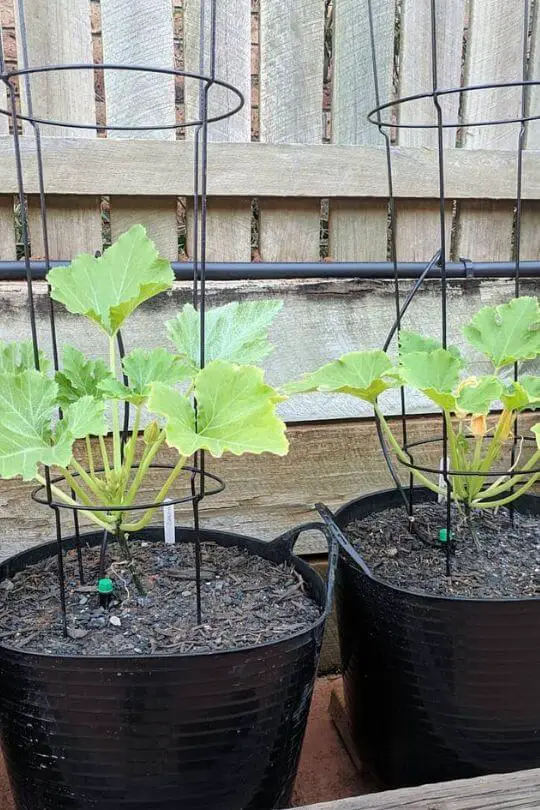If you’re thinking of growing zucchini in pots, you might find yourself wondering what size pot is best. Well, fret not! In this article, we’ll explore the importance of choosing the right size pot for your zucchini plants. From the right balance of space to adequate drainage, we’ll uncover the secrets to ensuring your zucchini plants thrive in their containers. So, get ready to unleash your green thumb and discover the perfect pot size for your zucchini!
Factors to Consider
When choosing the right pot size for your zucchini plants, there are several factors that you need to consider to ensure their optimal growth and health. These factors include the available space, plant size, root system, and watering needs. By taking these factors into account, you can provide the best environment for your zucchini plants to thrive.
Available Space
The first factor to consider when selecting a pot size for your zucchini plants is the available space you have. If you have limited space, such as a balcony or small patio, you may need to choose a smaller pot size that can fit in the available area. On the other hand, if you have a larger outdoor space, you can opt for bigger pots or even raised beds to accommodate multiple zucchini plants. It’s important to ensure that the pot size fits well within your gardening area without compromising the plants’ growth.
Plant Size
Another crucial factor to consider is the size of the zucchini plants themselves. Different varieties of zucchini can vary in size, with some growing to be compact and bushy while others can become quite sprawling. It’s important to research the specific variety you are planning to grow and understand its mature size. This will help you determine the appropriate pot size to provide enough room for the plant to grow, spread its leaves, and produce bountiful zucchinis.
Root System
Zucchini plants have a relatively extensive root system that needs adequate space to grow and absorb nutrients efficiently. Therefore, it’s important to choose a pot size that accommodates the plant’s root system. A pot with sufficient depth and width will allow the roots to spread and develop properly. Neglecting the root system’s needs may result in stunted growth and subpar Zucchini production.
Watering Needs
Different plants have varying watering requirements, and zucchini plants are no exception. Zucchinis generally prefer consistently moist soil, and the pot size can play a significant role in maintaining the appropriate moisture levels. Smaller pots tend to dry out more quickly, and larger pots can retain moisture for longer periods. Consider your watering routine and the climate in your area when choosing the pot size to ensure that your zucchini plants receive the appropriate amount of water.
Types of Pots
When it comes to choosing a pot for your zucchini plants, there are several options available. Each type of pot has its own advantages and considerations, so it’s essential to understand the characteristics of each before making your decision.
Plastic Pots
Plastic pots are lightweight, affordable, and come in various sizes. They are easy to move around and can withstand different weather conditions. However, they may not provide the best insulation for the roots, and the plants’ soil may heat up faster in plastic pots compared to other materials.
Terracotta Pots
Terracotta pots are made from clay and have a traditional, rustic appearance that many gardeners enjoy. They are porous, allowing for better airflow and drainage. However, terracotta pots can dry out more quickly, requiring more frequent watering. They are also prone to cracking in freezing temperatures, so they may not be suitable for colder climates.
Fabric Grow Bags
Fabric grow bags have gained popularity among gardeners as they offer excellent drainage and aeration for the plants’ root systems. These bags are made from durable fabric that allows excess water to escape, preventing overwatering issues. Moreover, they are lightweight and easy to move around, making them a flexible option for zucchini planting.
Self-Watering Pots
Self-watering pots have a reservoir at the bottom that provides a constant supply of water to the plants. They are ideal for busy gardeners or those who want to ensure consistent watering without constant monitoring. The self-watering feature can be particularly beneficial for zucchini plants, which require consistent moisture. However, it’s important to monitor the pot’s water level and ensure the reservoir doesn’t become a breeding ground for mosquitoes.
Raised Beds
If you have ample outdoor space, raised beds can be an excellent option for growing zucchini. Raised beds allow for better drainage, prevent soil compaction, and provide ample room for multiple zucchini plants. They also allow for easier maintenance and harvesting. However, building raised beds can be a more significant investment in terms of time and resources.

Determining the Ideal Pot Size
Determining the ideal pot size for your zucchini plants depends on various factors such as the plant’s requirements and your available space. It’s important to consider the minimum, recommended, and maximum pot size to ensure the best results for your plants.
Minimum Pot Size
The minimum pot size for zucchini plants should be around 5 gallons (19 liters) per plant. This size allows enough room for the plant’s roots to develop and ensures that the plant can adequately access the necessary nutrients and moisture. Going below this minimum size may result in stunted growth and reduced yields.
Recommended Pot Size
For optimal growth and productivity, it is generally recommended to use pots that measure around 10 to 15 gallons (38 to 57 liters) per plant. These sizes provide ample space for the zucchini’s root system to spread and access nutrients efficiently. They also help maintain moisture levels and reduce the risk of the pot drying out too quickly.
Maximum Pot Size
The maximum pot size will largely depend on the available space and your gardening goals. If you have limited space, it may not be practical to choose very large pots. However, if space is not an issue, opting for pots that are 20 gallons (76 liters) or larger can be beneficial. These larger pots allow for even more extensive root growth and can support multiple zucchini plants, increasing overall yields.
Optimal Zucchini Pot Sizes
The ideal pot size for zucchini plants will also vary depending on whether you are growing a single plant or multiple plants in the same container.
For Individual Plants
For growing a single zucchini plant, a pot size between 10 to 15 gallons (38 to 57 liters) would be ideal. This size allows the plant to have sufficient space for its roots to grow and access nutrients. It also ensures that the plant has enough room to spread its leaves and produce an abundant crop of zucchinis.
For Multiple Plants
If you plan to grow multiple zucchini plants in the same pot or container, it’s important to provide ample space for each plant’s root system. In this case, a larger pot size of 20 gallons (76 liters) or more would be suitable. This allows each plant to have its own space and reduces competition for nutrients and water, resulting in healthier and more productive zucchini plants.

Calculating Pot Volume
Calculating the pot volume can help you determine the suitable size for your zucchini plants. There are two common methods to estimate the pot volume: using the rule of thumb and considering the zucchini plant’s mature size.
Using the Rule of Thumb
A common rule of thumb for pot volume calculation is to use a ratio of 2:1:1 for zucchini plants. This means that the pot should be two parts soil or growing medium, one part compost, and one part organic matter. By following this ratio, you can ensure that the zucchini plants have adequate nutrients and access to moisture.
Using Zucchini Plant’s Mature Size
Another way to calculate the pot volume is to consider the mature size of the zucchini plant. Research your chosen zucchini variety and note the approximate size it is expected to reach at maturity. With this information, you can estimate the necessary pot size by considering the space the plant will require for optimal growth and productivity.
Pros and Cons of Different Pot Sizes
Different pot sizes have their advantages and considerations depending on your specific gardening situation. Here are the pros and cons of smaller, medium-sized, and larger pots to help you make an informed decision.
Smaller Pots
Smaller pots, such as those around 5 gallons (19 liters), have the advantage of being lightweight and easier to move around. They are also an ideal choice for smaller gardening spaces. However, smaller pots tend to dry out more quickly and may require more frequent watering. They provide less room for the roots to grow, which can lead to restricted growth and smaller yields.
Medium-Sized Pots
Choosing pot sizes between 10 to 15 gallons (38 to 57 liters) offers a good balance between manageability and plant growth. These medium-sized pots provide sufficient room for root development and efficient nutrient absorption. They are also easier to maintain and less prone to drying out too quickly. Medium-sized pots are particularly suitable for individual zucchini plants, providing the space they need to thrive.
Larger Pots
Larger pots, such as those 20 gallons (76 liters) or more, offer the advantage of providing ample space for extensive root growth. They are ideal for accommodating multiple zucchini plants or if you have a large gardening space. Larger pots retain moisture for longer periods, reducing the need for frequent watering. However, they can be heavier and more challenging to move. Additionally, they may not be practical if you have limited space or are growing zucchinis in a balcony or patio setting.

Transplanting Zucchini
Transplanting zucchini plants is a common gardening practice that allows you to start the plants indoors and later move them to larger pots or the garden. To ensure successful transplanting, it’s important to follow certain steps and choose the right pot size for the process.
Steps for Transplanting
- Start by germinating the zucchini seeds in small seedling trays or containers filled with a seed-starting mix.
- Once the seedlings have developed a couple of true leaves, it’s time to transplant them to their permanent pots.
- Choose a pot that is at least 4 inches (10 cm) larger in diameter than the seedling container to provide adequate space for root growth.
- Fill the new pot with a high-quality potting mix, leaving enough space for the seedling’s root ball.
- Carefully remove the zucchini seedling from its original container, taking care not to damage the delicate roots.
- Place the seedling in the center of the new pot and gently backfill it with soil until the seedling is at the same depth as before.
- Press lightly around the base of the seedling to ensure good soil-to-root contact.
- Water the transplanted zucchini plant thoroughly and place it in a suitable location with adequate sunlight.
Choosing the Right Pot Size for Transplanting
When transplanting zucchini seedlings, it’s important to choose a pot that provides enough space for the young plants to grow and establish themselves. A pot size around 4 inches (10 cm) larger in diameter than the seedling container is generally suitable. This size ensures that the zucchini plant has sufficient room to develop its roots and continue growing without becoming root-bound.
Caring for Zucchini in Pots
Proper care is essential to ensure the health and productivity of your zucchini plants in pots. Here are some important aspects to consider: watering, fertilizing, pruning, and monitoring for pests and diseases.
Watering
Zucchini plants require consistent moisture to thrive, especially when grown in pots. Monitor the moisture levels in the soil and water the plants whenever the top inch of soil feels dry. Avoid overwatering, as it can lead to root rot and other issues. Self-watering pots can be beneficial in maintaining the appropriate moisture levels, but regular monitoring is still necessary.
Fertilizing
To support vigorous growth and abundant zucchini production, regular fertilization is essential. Choose a balanced organic fertilizer and apply it according to the manufacturer’s instructions. Additionally, consider incorporating compost or well-rotted manure into the potting mix during planting to provide a steady release of nutrients throughout the growing season.
Pruning
Zucchini plants have a tendency to sprawl and take up a lot of space. Regular pruning can help control their growth and promote better airflow, reducing the risk of diseases. Prune away any dead or damaged leaves, as well as excessive foliage that can shade the developing zucchinis. Pruning can also help redirect the plant’s energy towards fruit production.
Monitoring for Pests and Diseases
Regularly monitor your zucchini plants for signs of pests or diseases. Common pests that can affect zucchinis include aphids, squash bugs, and vine borers. If you notice any signs of infestation or disease, take appropriate measures such as using organic insecticides or fungicides, or employing natural pest control methods to protect your plants.

Common Mistakes to Avoid
When selecting pot sizes for your zucchini plants, it’s crucial to avoid certain common mistakes that can impact their growth and productivity.
Choosing an Insufficiently Large Pot
One of the most common mistakes is selecting a pot size that is too small for the zucchini plants’ needs. Insufficiently large pots can restrict root growth and nutrient uptake, leading to stunted growth and decreased yields. Always choose a pot size that allows ample space for the zucchini plant’s root system to develop and expand.
Overcrowding Zucchini Plants
Overcrowding zucchini plants in a single pot can lead to intense competition for resources, including water, nutrients, and sunlight. This can result in poor growth, limited fruit production, and an increased risk of disease. It’s important to provide enough space for each zucchini plant to thrive individually, even if you are growing multiple plants in the same container.
Conclusion
Choosing the right pot size for your zucchini plants is crucial for their success and productivity. Considering factors such as available space, plant size, root system, and watering needs can help you make an informed decision. Whether you opt for plastic pots, terracotta pots, fabric grow bags, self-watering pots, or raised beds, each pot type has its own advantages and considerations. By understanding the ideal pot size, calculating pot volume, and avoiding common mistakes, you can provide the optimal growing conditions for your zucchini plants. With proper care and attention, you can enjoy a bountiful harvest of delicious zucchinis from your potted garden.




